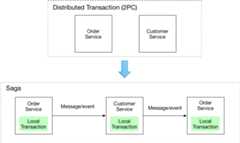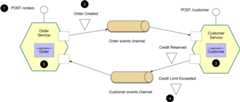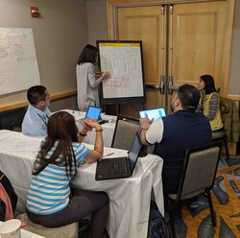Microservice Architecture
Supported byKongPattern: Saga
pattern transaction management sagas service collaboration implementing commandsWant to learn more about this pattern?
Take a look at myself-paced, online bootcamp that teaches you how to use the Saga, API Composition, and CQRS patterns to design operations that span multiple services.
The regular price is $395/person but use coupon OFFEFKCW to sign up for $95 (valid until Sept 30th, 2025)

Context
You have applied theDatabase per Service pattern.Each service has its own database.Some business transactions, however, span multiple service so you need a mechanism to implement transactions that span services.For example, let’s imagine that you are building an e-commerce store where customers have a credit limit.The application must ensure that a new order will not exceed the customer’s credit limit.Since Orders and Customers are in different databases owned by different services the application cannot simply use a local ACID transaction.
Problem
How to implement transactions that span services?
Forces
- 2PC is not an option
Solution
Implement each business transaction that spans multiple services as a saga.A saga is a sequence of local transactions.Each local transaction updates the database and publishes a message or event to trigger the next local transaction in the saga.If a local transaction fails because it violates a business rule then the saga executes a series of compensating transactions that undo the changes that were made by the preceding local transactions.

There are two ways of coordination sagas:
- Choreography - each local transaction publishes domain events that trigger local transactions in other services
- Orchestration - an orchestrator (object) tells the participants what local transactions to execute
Example: Choreography-based saga

An e-commerce application that uses this approach would create an order using a choreography-based saga that consists of the following steps:
- The
Order Servicereceives thePOST /ordersrequest and creates anOrderin aPENDINGstate - It then emits an
Order Createdevent - The
Customer Service’s event handler attempts to reserve credit - It then emits an event indicating the outcome
- The
OrderService’s event handler either approves or rejects theOrder
Take a tour of an example saga
Example: Orchestration-based saga

An e-commerce application that uses this approach would create an order using an orchestration-based saga that consists of the following steps:
- The
Order Servicereceives thePOST /ordersrequest and creates theCreate Ordersaga orchestrator - The saga orchestrator creates an
Orderin thePENDINGstate - It then sends a
Reserve Creditcommand to theCustomer Service - The
Customer Serviceattempts to reserve credit - It then sends back a reply message indicating the outcome
- The saga orchestrator either approves or rejects the
Order
Take a tour of an example saga
Resulting context
This pattern has the following benefits:
- It enables an application to maintain data consistency across multiple services without using distributed transactions
This solution has the following drawbacks:
Lack of automatic rollback - a developer must design compensating transactions that explicitly undo changes made earlier in a saga rather than relying on the automatic rollback feature of ACID transactions
Lack of isolation (the “I” in ACID) - the lack of isolation means that there’s risk that the concurrent execution of multiple sagas and transactions can use data anomalies. consequently, a saga developer must typical use countermeasures, which are design techniques that implement isolation. Moreover, careful analysis is needed to select and correctly implement the countermeasures. SeeChapter 4/section 4.3 of my book Microservices Patterns for more information.
There are also the following issues to address:
In order to be reliable, a service must atomically update its databaseand publish a message/event.It cannot use the traditional mechanism of a distributed transaction that spans the database and the message broker.Instead, it must use one of the patterns listed below.
A client that initiates the saga, which an asynchronous flow, using a synchronous request (e.g. HTTP
POST /orders) needs to be able to determine its outcome.There are several options, each with different trade-offs:- The service sends back a response once the saga completes, e.g. once it receives an
OrderApprovedorOrderRejectedevent. - The service sends back a response (e.g. containing the
orderID) after initiating the saga and the client periodically polls (e.g.GET /orders/{orderID}) to determine the outcome - The service sends back a response (e.g. containing the
orderID) after initiating the saga, and then sends an event (e.g. websocket, web hook, etc) to the client once the saga completes.
- The service sends back a response once the saga completes, e.g. once it receives an
Related patterns
- TheDatabase per Service pattern creates the need for this pattern
- The following patterns are ways toatomically update stateand publish messages/events:
- A choreography-based saga can publish events usingAggregates andDomain Events
- TheCommand-side replica is an alternative pattern, which can replace saga step that query data
Learn more
- My bookMicroservices patterns describes this pattern in a lot more detail. The book’sexample application implements orchestration-based sagas using theEventuate Tram Sagas framework
- Take a look at myself-paced, online bootcamp that teaches you how to use the Saga, API Composition, and CQRS patterns to design operations that span multiple services.
- Read thesearticles about the Saga pattern
- Mypresentations on sagas and asynchronous microservices.
Example code
The following examples implement the customers and orders example in different ways:
- Choreography-based saga where the services publish domain events using theEventuate Tram framework
- Orchestration-based saga where the
Order Serviceuses a saga orchestrator implemented using theEventuate Tram Sagas framework - Choreography and event sourcing-based saga where the services publish domain events using theEventuate event sourcing framework
pattern transaction management sagas service collaboration implementing commands
About Microservices.io
Microservices.io is brought to you byChris Richardson. Experienced software architect, author of POJOs in Action, the creator of the original CloudFoundry.com, and the author of Microservices patterns.
Microservices Patterns, 2nd edition

I am very excited to announce that the MEAP for the second edition of my book, Microservices Patterns is now available!
Learn moreASK CHRIS
Got a question about microservices?
Fill inthis form. If I can, I'll write a blog post that answers your question.
NEED HELP?

I help organizations improve agility and competitiveness through better software architecture.
Learn more about myconsulting engagements, andtraining workshops.
PREMIUM CONTENT
 Premium content now available for paid subscribers atpremium.microservices.io.
Premium content now available for paid subscribers atpremium.microservices.io.MICROSERVICES WORKSHOPS

Chris teachescomprehensive workshops for architects and developers that will enable your organization use microservices effectively.
Avoid the pitfalls of adopting microservices and learn essential topics, such as service decomposition and design and how to refactor a monolith to microservices.
Learn moreRemote consulting session

Got a specific microservice architecture-related question? For example:
- Wondering whether your organization should adopt microservices?
- Want to know how to migrate your monolith to microservices?
- Facing a tricky microservice architecture design problem?
Consider signing up for atwo hour, highly focussed, consulting session.
ASSESS your architecture
Assess your application's microservice architecture and identify what needs to be improved.Engage Chris to conduct an architect review.
LEARN about microservices
Chris offers numerous other resources for learning the microservice architecture.
Example microservices applications
Want to see an example? Check out Chris Richardson's example applications.See code
Virtual bootcamp: Distributed data patterns in a microservice architecture

My virtual bootcamp, distributed data patterns in a microservice architecture, is now open for enrollment!
It covers the key distributed data management patterns including Saga, API Composition, and CQRS.
It consists of video lectures, code labs, and a weekly ask-me-anything video conference repeated in multiple timezones.
The regular price is $395/person but use coupon OFFEFKCW to sign up for $95 (valid until Sept 30th, 2025). There are deeper discounts for buying multiple seats.
Learn how to create a service template and microservice chassis
Take a look at myManning LiveProject that teaches you how to develop a service template and microservice chassis.

BUILD microservices
Consulting services
Engage Chris to create a microservices adoption roadmap and help you define your microservice architecture,
The Eventuate platform
Use theEventuate.io platform to tackle distributed data management challenges in your microservices architecture.

Eventuate is Chris's latest startup. It makes it easy to use the Saga pattern to manage transactions and the CQRS pattern to implement queries.
Join themicroservices google group
